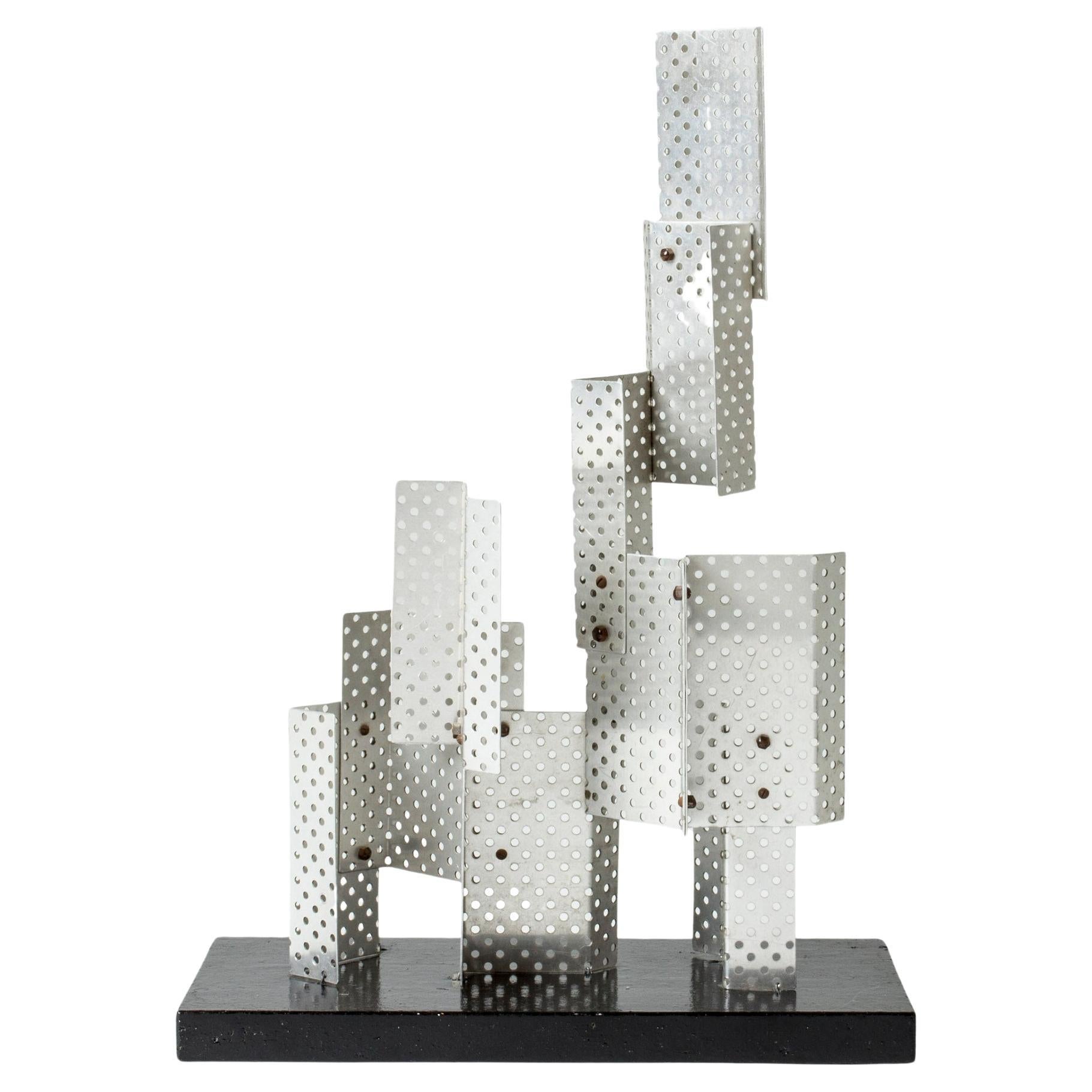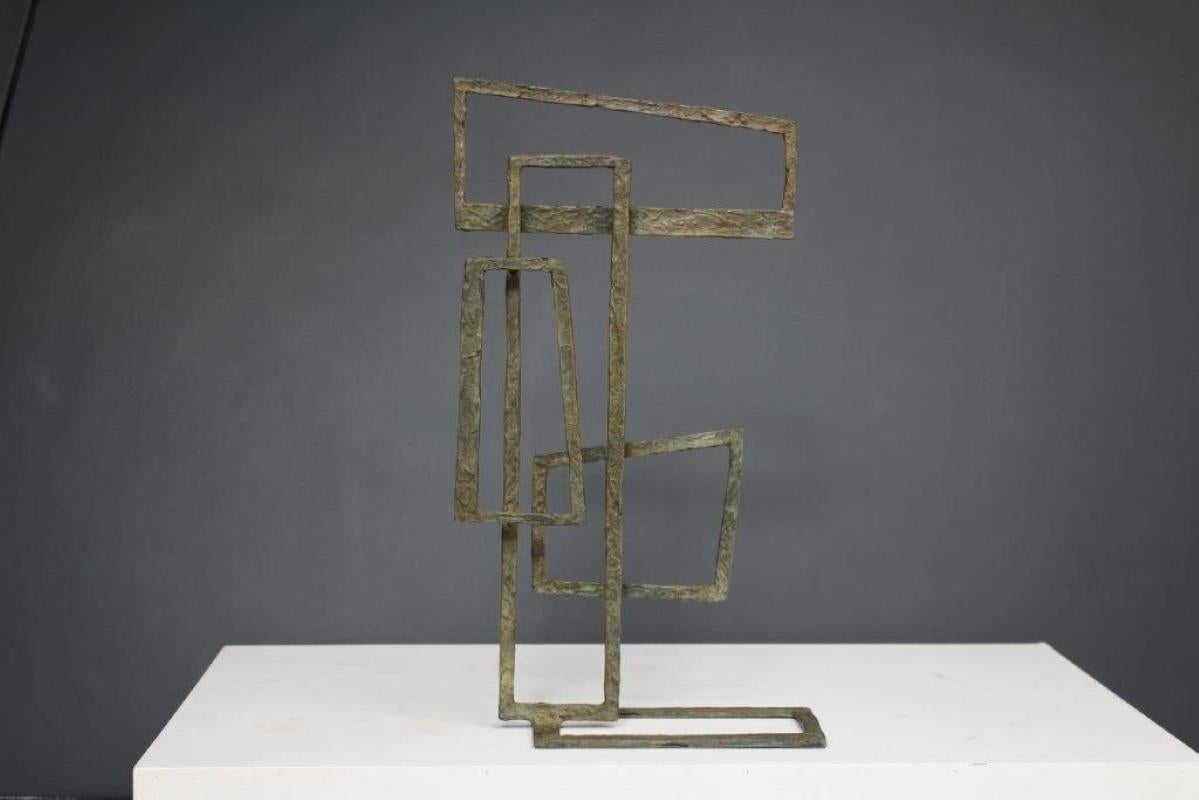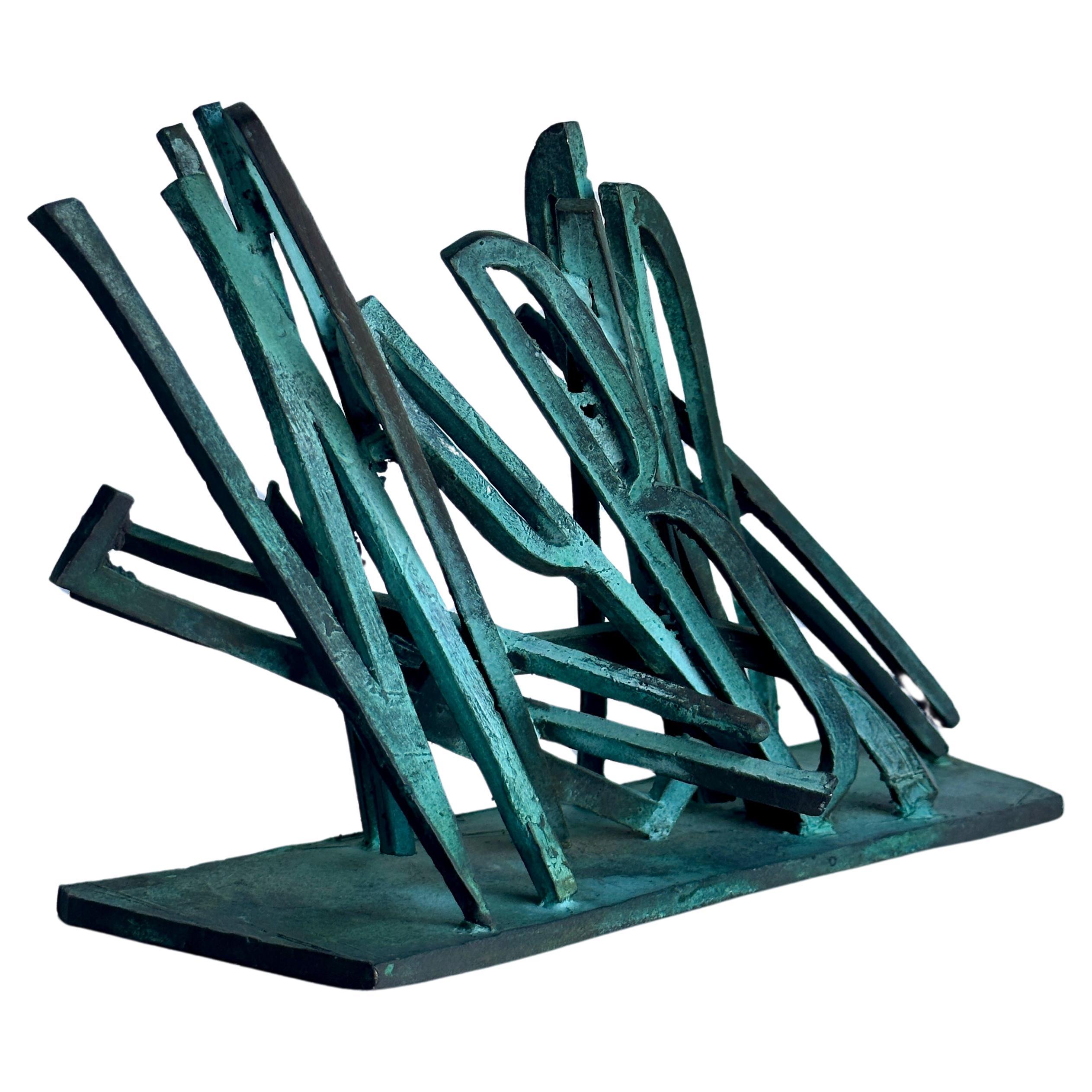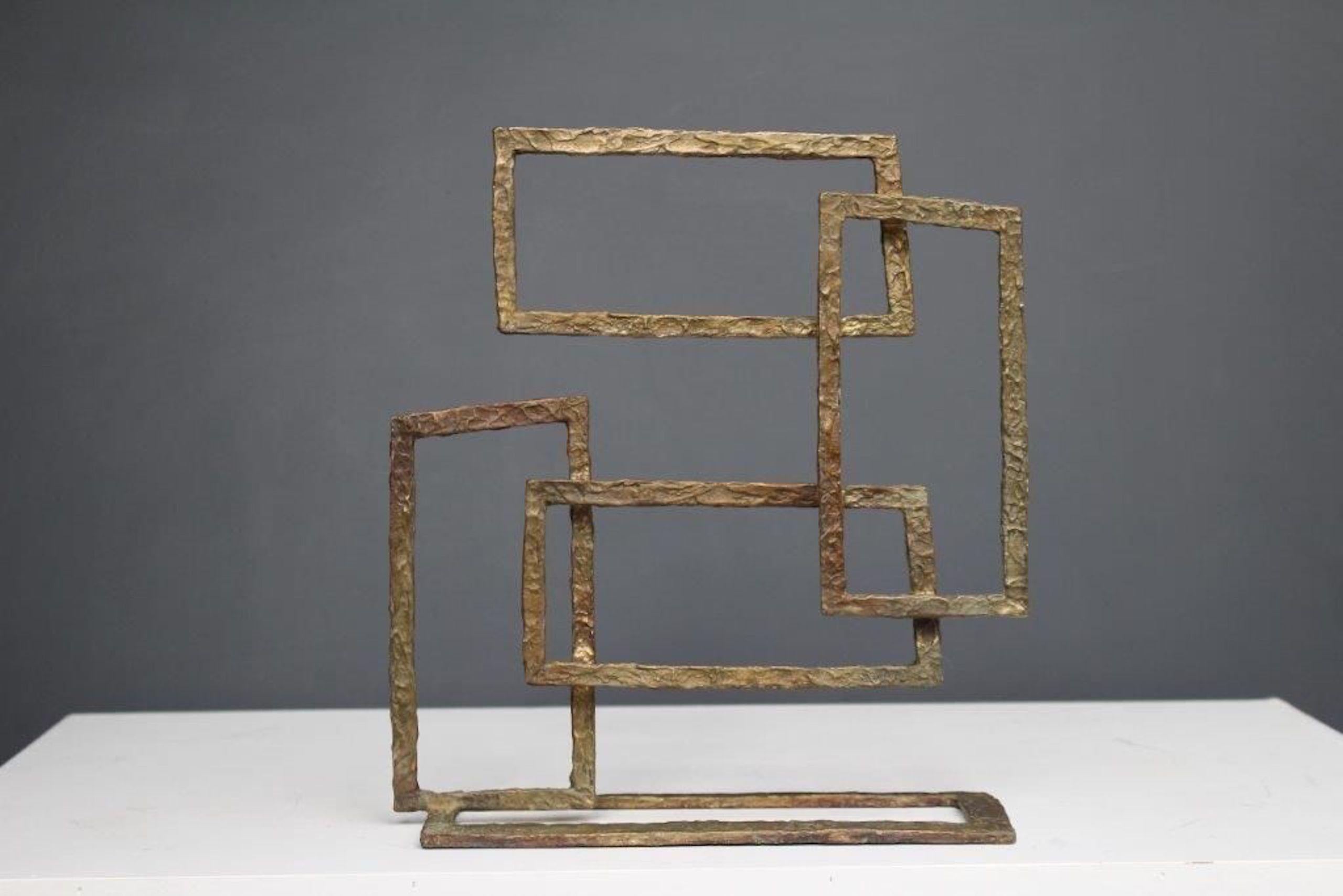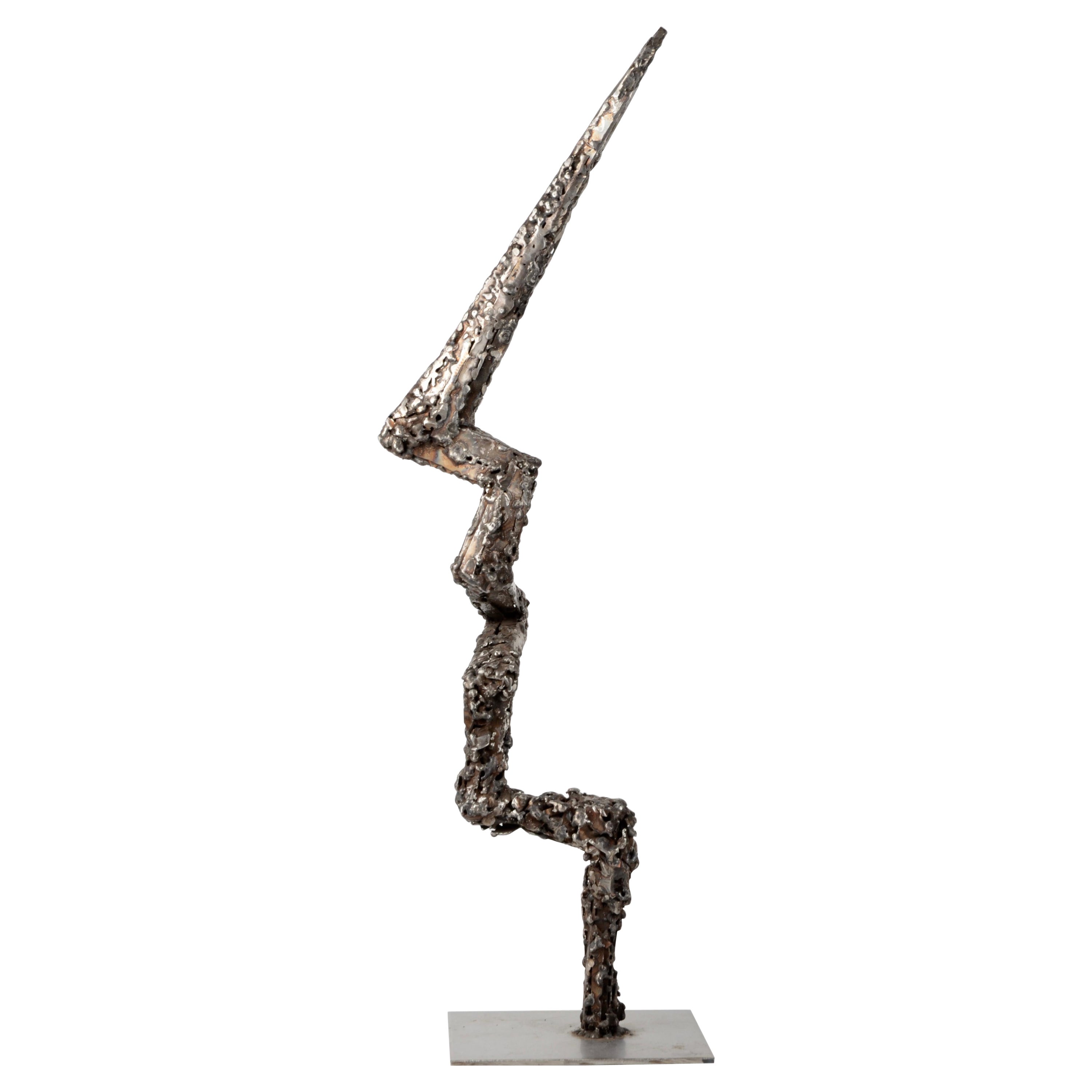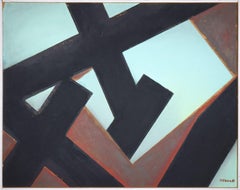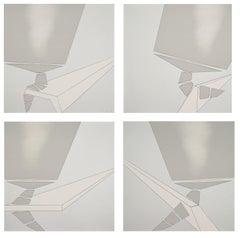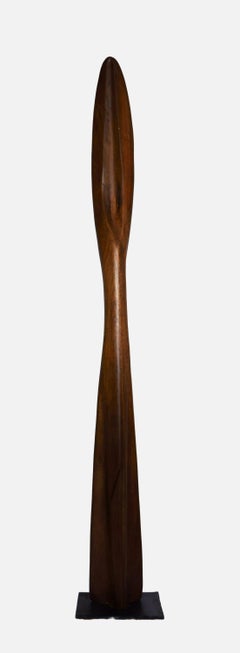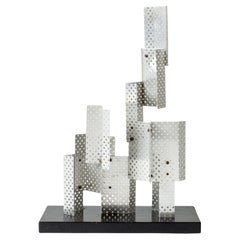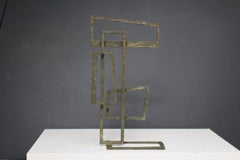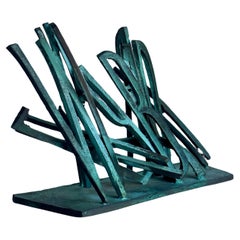Articoli simili a Gradual Rotation / - Dynamic Tectonics -
Vuoi altre immagini o video?
Richiedi altre immagini o video al venditore
1 di 9
Thomas RöthelGradual Rotation / - Dynamic Tectonics -c. 2005
c. 2005
4500 €IVA inclusa
Informazioni sull’articolo
Thomas Röthel (*1969 Ansbach), Gradual Rotation, around 2005. Steel with rust patina mounted on stone plate. Overall dimensions: 38 cm (height) x 34 cm (width) x 27 cm (depth), weight 12.3 kg.
- in excellent condition
- Dynamic Tectonics -
The two equally sized steel blocks appear to have once formed a single block. In combination with the horizontal stone slab, the vertical blocks exude an architectural calm that makes the dynamic action between the steel blocks, now divided into two equal bodies, seem all the more energetic. As if the inherent forces of the block had been released explosively, it is torn open in the middle to form a crescendo.
However, the release of the inner forces has not resulted in the original cuboid splitting into two separate vertical bodies; rather, the two parts are connected by the filigree lines of force and perform an intrinsically balanced balancing act. The dynamics, in turn, flow into an overarching calmness that is, however, supported by a virtuoso structure of tension. The dynamic is by no means at a standstill within the stillness, but is constantly in progress, as can be seen by walking around the sculpture. The processual character of the ongoing event is also illustrated by the film of rust, which - like the release of inner forces - is also a material process.
While Richard Serra creates spaces of tension with his steel sculptures, Thomas Röthel releases the material's internal potential for tension and reveals the dynamic order inherent in tectonics. If Serra's sculptures transcend the human scale and thus create a sublime effect, Röthel's steel plates, which float on space-bending lines of force, also unfold a sublime effect.
"Every line, every curve can be calculated in advance with mathematical precision according to the given conditions of the material. And yet there is only one moment of genesis that cannot be grasped by the mind, in which a simple block of steel becomes a work of art beyond mathematics and physics. In the hands of Thomas Röthel, the scientific laws inherent in this work of art become poetry in form.
- Erich Schneider
About the artist
After training as a wood sculptor from 1986 to 1989, Thomas Röthel studied at the Academy of Fine Arts in Nuremberg with Johannes P. Hölzinger. Since then he has worked as a freelance artist in Oberdachstetten.
Röthel mainly creates steel sculptures in his own workshop. Since 2015, he has also been using the production halls of SFG STEELforming GmbH in Burbach in the Siegerland, with whom the American sculptor Richard Serra also works.
Selected Bibliography
Thomas Röthel. Steel Sculptures 1997 - 2008, Edition Kittelberger, Reutlingen 2009.
GERMAN VERSION
Thomas Röthel (*1969 Ansbach), Graduelle Drehung, um 2005. Stahl mit Flugrostpatina auf Steinplatte montiert. Gesamtmaß: 38 cm (Höhe) x 34 cm (Breite) x 27 cm (Tiefe), Gewicht 12,3 kg.
- ausgezeichnet erhalten
- Dynamische Tektonik -
Die zwei gleich großen Stahlquader haben offensichtlich einmal einen einzigen Block gebildet. Im Verbund mit der horizontalen Steinplatte strahlen die vertikalen Quader eine architektonische Ruhe aus, die das dynamische Geschehen zwischen den nunmehr in zwei gleichgroße Körper zerteilen Stahlquader umso energetischer erscheinen lassen. Als ob dem Block innewohnende Kräfte explosionsartig freigesetzt worden wären, ist er ist mittig zu einem Formcrescendo aufgerissen.
Das Ausagieren der inneren Kräfte hat jedoch nicht dazu geführt, dass der ursprüngliche Quader in zwei voneinander getrennte Vertikalkörper separiert worden wäre, vielmehr sind beide Teile durch die filigranen Kraftlinien aneinandergebunden und vollführen einen in sich austarierten Balanceakt. Die Dynamik mündet wiederum in eine übergeordnete Ruhe ein, die allerdings durch ein virtuoses Spannungsgefüge getragen wird. Die Dynamik ist innerhalb der Ruhe keineswegs stillgestellt, sondern beständig im Gange, was sich im Umgehen der Skulptur offenbart. Das Prozessuale des andauernden Geschehens wird auch durch den Flugrost veranschaulicht, der – wie das Freisetzen der inneren Kräfte – ebenfalls ein Materialprozess ist.
Schafft Richard Serra mit seinen Stahlskulpturen Spannungsräume, so setzt Thomas Röthel das materialinterne Spanungspotenzial frei und offenbart das der Tektonik innewohnende dynamische Ordnungsgefüge. Übersteigen Sierras Skulpturen das menschliche Maß und erzeugen dadurch eine Erhabenheit, entfalten auch Röthels auf raumverkrümmenden Kraftlinien schwebende Stahlplatten eine Erhabenheitswirkung.
„Jede Linie, jede Krümmung ist gemäß den gegebenen Bedingungen des Materials mit mathematischer Genauigkeit vorher berechenbar. Und doch gibt es nur einen mit dem Verstand eben nicht fassbaren Moment der Genese, bei dem aus einem schlichten Stahlblock ein Kunstwerk jenseits von Mathematik und Physik wird. Unter den Händen von Thomas Röthel werden die diesem innewohnenden naturwissenschaftlichen Gesetzmäßigkeiten zur Gestalt gewordenen Poesie.“
- Erich Schneider
zum Künstler
Im Anschluss an eine Ausbildung zum Holzbildhauer von 1986 bis 1989 studierte Thomas Röthel an der Kunstakademie Nürnberg bei Johannes P. Hölzinger. Seitdem ist er in Oberdachstetten als freischaffender Künstler tätig.
Röthel kreiert vorwiegend Stahlskulpturen, die er in der eigenen Atelier-Werkstatt anfertigt. Seit 2015 nutzt er zudem die Produktionshallen der SFG STEELforming GmbH in Burbach im Siegerland, mit der auch der amerikanische Bildhauer Richard Serra zusammenarbeitet.
Auswahlbibliographie
Thomas Röthel. Stahlskulpturen 1997 - 2008. Edition Kittelberger, Reutlingen 2009.
- Creatore:Thomas Röthel (1969, Tedesco)
- Anno di creazione:c. 2005
- Dimensioni:Altezza: 38 cm (14,97 in)Larghezza: 34 cm (13,39 in)Profondità: 27 cm (10,63 in)
- Tecnica:
- Movimento e stile:
- Periodo:
- Condizioni:
- Località della galleria:Berlin, DE
- Numero di riferimento:1stDibs: LU2438215572132
Informazioni sul venditore
5,0
Venditore professionale selezionato
Ogni venditore supera rigorosi standard di autenticità e affidabilità
Fondazione nel 2014
Venditore 1stDibs dal 2023
21 vendite su 1stDibs
- SpedizioneRecupero del preventivo…Spedizione da: Berlin, Germania
- Politica di reso
Alcune parti di questa pagina sono state tradotte automaticamente. 1stDibs non può garantire che le traduzioni siano corrette. L’inglese è la lingua predefinita del sito.
Garanzia di autenticità
Nell’improbabile caso in cui si verifichi un problema con l’autenticità di un articolo, contattaci entro un anno per ottenere un rimborso completo. DettagliGaranzia di rimborso
Se il tuo articolo non corrisponde alla descrizione, è danneggiato durante il trasporto o non arriva, contattaci entro 7 giorni per un rimborso completo. DettagliAnnullamento entro 24 ore
Hai un periodo di tolleranza di 24 ore per annullare il tuo acquisto, senza necessità di fornire spiegazioni.Venditori professionali selezionati
I nostri venditori di livello internazionale devono aderire a rigorosi standard di servizio e qualità, garantendo l’integrità delle inserzioni.Garanzia miglior prezzo
Se scopri che un venditore ha pubblicato altrove lo stesso articolo a un prezzo più basso, applicheremo lo stesso prezzo.Consegna globale affidabile
La nostra rete di vettori leader del settore offre opzioni di spedizione specializzate in tutto il mondo, inclusa la consegna personalizzata.Altro da questo venditore
Mostra tuttoTensione tettonica / - Gli archetipi della pittura
Jürgen Möbius (*1939 Großenhain), Tensione tettonica. Olio su tavola rigida, 47,5 x 60 cm, 49 x 61,5 cm (cornice), firmato in basso a destra "Möbius" e datato "[19]81".
- Angolo sup...
Categoria
Anni 1980, Astratto, Dipinti astratti
Materiali
Olio
1120 € Prezzo promozionale
20% in meno
Senza titolo / - Scultura danzante -
Di Gerlinde Beck
Gerlinde Beck (1930 Stoccarda-Cannstatt - 2006 Mühlacker-Großglattbach), Senza titolo, 1973. Serie di quattro serigrafie, 29,8 cm x 29,8 cm, ciascuna firmata in piombo sul fronte e n...
Categoria
Anni 1970, Astrattismo geometrico, Stampe astratte
Materiali
Carta
Forma vegetativa / - Arte coltivata -
Paul Dierkes (1907 Cloppenburg - 1968 Berlino), Forma vegetativa. Mogano, 1958. 142 x 16 x 10 cm (scultura), 21 x 17,5 cm (base), monogramma "PD" sul retro.
- Grown Art -
Oltre...
Categoria
Anni 1950, Dopoguerra, Sculture astratte
Materiali
Mogano
2800 € Prezzo promozionale
20% in meno
Senza titolo / - L'arcaismo della Nature -
Jorge Machold (1940 Chemnitz - 2015 Berlino), Senza titolo, 1973. Acquaforte a colori, 41,5 x 29,2 cm (formato lastra), 49,5 cm x 39,5 cm (formato foglio), firmata in basso a destra ...
Categoria
Anni 1970, Astratto, Stampe astratte
Materiali
Carta
Collage con applicazione di metallo / - Ritmo e Riflessione -
Hermann Goepfert (1926 Bad Nauheim - 1982 Anversa), Collage con applicazione di metallo, 1965. Contributo n. 14 dell'antologia "La lune en rodage II" pubblicata dalle Edizioni Pander...
Categoria
Anni 1990, Astratto, Tecnica mista
Materiali
Carta
Animale raro / - Figurazione astratta -
Veit Hofmann (*1944 Dresda), Animale raro, 1987. Olio su cartoncino leggero, 42 cm (altezza) x 30 cm (larghezza), monogramma "V.I.H." in basso a destra e data "[19]87", titolo "Selte...
Categoria
Anni 1980, Espressionismo astratto, Dipinti astratti
Materiali
Olio
Ti potrebbe interessare anche
Scultura di Lars Erik Falk, Svezia, 1968
Di Lars Erik Falk
Scultura sorprendente di Lars Erik Falk, realizzata in alluminio perforato con fori. Le diverse angolazioni creano un bellissimo gioco di luce.
Categoria
Vintage, Anni 1960, Scandinavo moderno, Sculture astratte
Materiali
Alluminio
Equilibrio Arquitectonico III, 2009
Il pittore e scultore Martín Carral ha studiato Belle Arti all'Università di Barcellona. Carral dipinge le onde gravitazionali da molti anni, un universo in espansione di pozzi abiss...
Categoria
XXI secolo e contemporaneo, Moderno, Sculture astratte
Materiali
Tecnica mista
Composition IV di Delphine Brabant - Scultura geometrica astratta in bronzo
Di Delphine Brabant
Composition IV è una scultura in bronzo dell'artista contemporanea Delphine Brabant, le cui dimensioni sono 48 × 24 × 12 cm (18,9 × 9,4 × 4,7 pollici).
La scultura è firmata e numer...
Categoria
Anni 2010, Contemporaneo, Sculture astratte
Materiali
Bronzo
Scultura alfabetica in bronzo di Sharbek Almajkov
Questa scultura in bronzo "alfabeto pendente" è firmata dall'artista, che era conosciuto con il suo nome di battesimo ma anche con un nome falso: si faceva chiamare Sharbek Almajkov....
Categoria
Fine XX secolo, Americano, Moderno, Sculture astratte
Materiali
Bronzo
Composition V di Delphine Brabant - Scultura geometrica astratta in bronzo
Di Delphine Brabant
Composition V è una scultura in bronzo dell'artista contemporanea Delphine Brabant, le cui dimensioni sono 33 × 30 × 11 cm (13 × 11,8 × 4,3 pollici).
La scultura è firmata e numerat...
Categoria
Anni 2010, Contemporaneo, Sculture astratte
Materiali
Bronzo
Torsten Treutiger (1932-2019), scultura "PROFIL II"
Scultura in acciaio, "PROFIL II", dell'artista svedese Torsten Treutiger. Firmato e contrassegnato con le informazioni dell'artista e con il prezzo stabilito dall'artista sul pezzo. ...
Categoria
Inizio anni 2000, Svedese, Postmoderno, Sculture astratte
Materiali
Acciaio inossidabile
